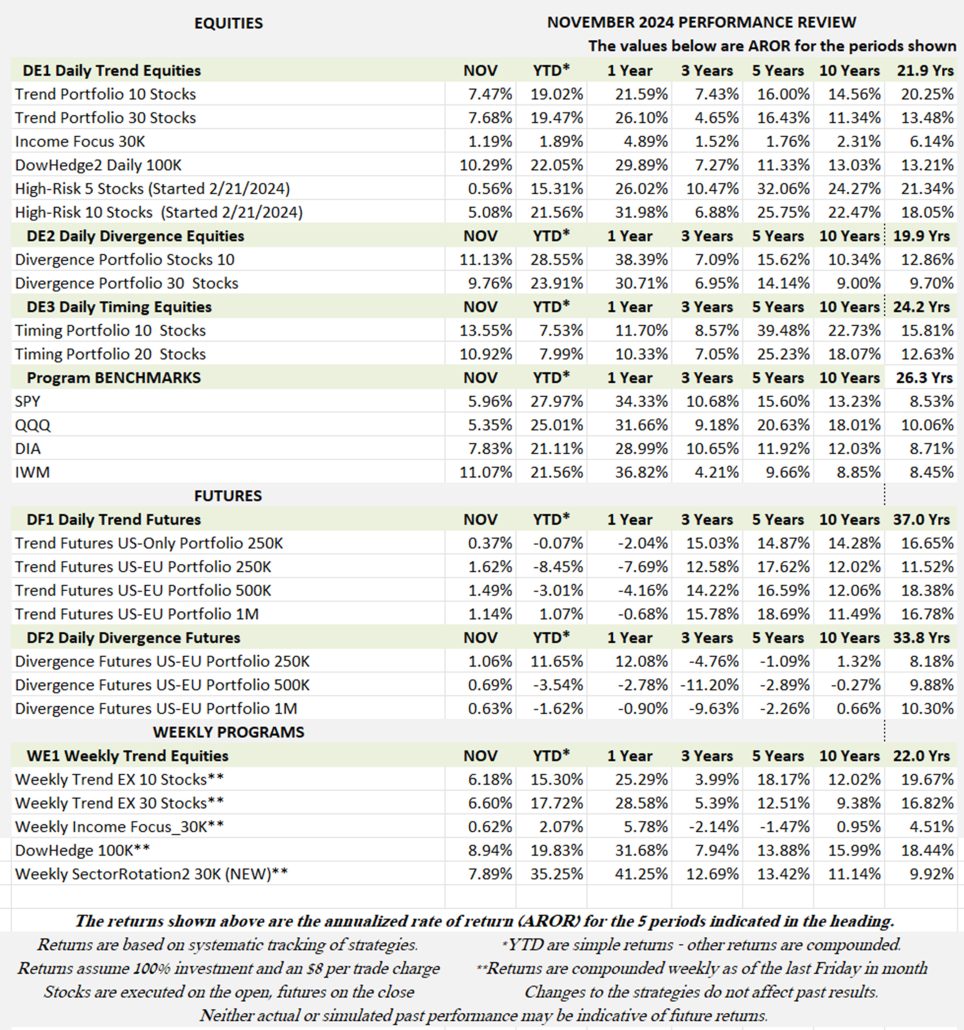
Industry Benchmark Performance
The industry performance has not been posted, but our summary of the ETF index markets (above) shows one of the best Novembers on record. It seems strange that with all the switching from tech and semi stocks into other areas, that results should be from 21% to 28% in the overall market. That’s a great year.
Less notable are the futures funds. Most have earned their profits using interest rates, which have defied forecasting. When the Fed started lower rates, we would normally expect a rally in futures, but that hasn’t happened. Rates are now caught between the Fed trying to lower rates and anticipated inflation due to the new administrations tariff policy.
Below is last month's fund performance. We'll catch up to this next month!

Source: BarclayHedge Indices.
Kaufman’sMost Popular Books (available on Amazon)
Trading Systems and Methods, 6th Edition. The complete guide to trading systems, with more than 250 programs and spreadsheets. The most important book for a system developer.
Kaufman Constructs Trading Systems. A step-by-step manual on how to develop, test, and trade an algorithmic system.
Learn To Trade. Written for both serious beginners and practiced traders, this book includes chart formations, trends, indicators, trading rules, risk, and portfolio management. You can find it in color on Amazon.
You can also find these books on our website, www.kaufmansignals.com.
Blogs and Recent Publications
Find Mr. Kaufman’s other recent publications and seminars at the end of this report. We post new interviews, seminars, and reference new articles by Mr. Kaufman each month.
November Performance in Brief
An excellent month for Equity performance, With our Benchmark Trend portfolio up by 19%, we won’t complain that we are below the SPY returns. After all, we have risk control to avoid going down by 50%.
Futures are the only disappointment. As we mentioned, a lot depends on interest rate trend, which are in a state of confusion. Given the conflicting policies of the Fed and the new administration, we don’t see much happening in December. However, the market always surprises.
Major Equity ETFs
The small caps (IWM) did some catching up to the both the SPY and QQQ in November, gaining 11% compared to 5% to 6% for the other indices. Buying was spread across the entire market, bring the index markets to new highs. Now we see if it can hold through December.

Insert Major Index
CLOSE-UP: Retail Sales for the Holidays
December is the month that makes or breaks retail sales. It is said to account for 18% of the annual sales. Personally, I thought it was higher. The news starts giving us an update right after Black Friday (the day after Thanksgiving), the official start of the shopping spree.
What companies benefit from the holiday season? Mostly retail, but also travel (airlines and hotels). The economy has been “iffy” for the past few years, starting with Covid and then higher interest rates. That seems to be less important now. My own experience is that it’s been harder to find a parking space in the shopping mall lot.
I’ve seen mixed results over the Black Friday weekend. Report have shows shopping higher by 4% but online shopping down. But then Cyber Monday is not yet here.
What Could Go Wrong?
We have a president-elect threatening tariffs of 25% on Mexican and Canadian imports, and 35% on Chinese products. While retailers won’t pass on all of those costs, prices will rise. But that won’t be until late January (if at all).
Rather than waiting to see what will happen, shoppers might stock up on goods that are likely to be subject to tariffs. That would be good news for retailers in the short term.
If you remember back to the early part of 2020, Trump started a trade war with China. The market dropped 40% in the next 2 months (see Chart 1), before he decided that it wasn’t a good idea. Stocks started back up. Is that likely to happen again? Even though we’re only interested in retail sales in December, anticipation can be a big part of retail shopping.
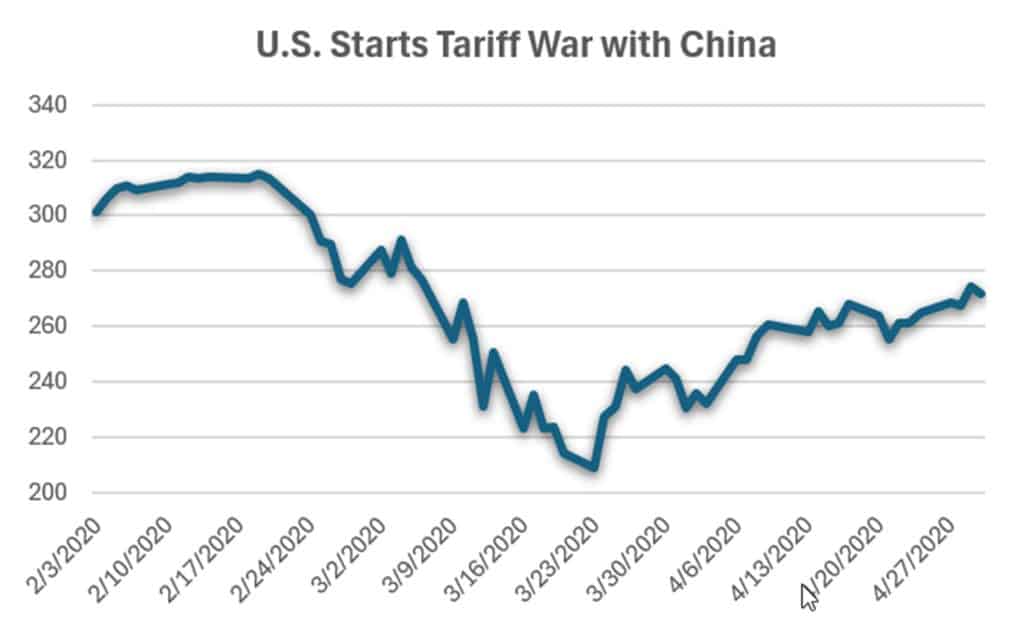
Chart 1. SPY falls on expectation of a trade war with China.
Seasonality
The way to decide if December is going to be good or bad is to look at the past seasonality. We can compare the last 5 years (a difficult periods) with the previous 20 years to see how companies have fared. I’ve looked at the seasonal averages, seasonal median, and seasonal volatility. They all show the same results, so we’ll only look at the seasonal average.
We’ll use the yearly average method, which takes the average of all stock prices within one year and then divides each month of that year by the average. That gives us a relative gain or loss when a month has better or worse prices compared to the average. We then average each month to get the seasonal pattern. It’s not perfect, but it seems to work well.
Retail Stores
Do people shop in stores? From the lack of parking spaces at the malls, it seems that they do. We’ll look at four stocks, Macy’s (M), Walmart (WMT), BestBuy (BBY), and Nordstrom’s (JWM) over two time periods do see how they have fared.
Macy’s have had trouble over the past years, but seems to rally in the holiday season (Chart 2). November and December sales offset most of the losses during the past five years, although the long-term trend seems to be down. It could be a short-term buy for December and January.

Chart 2. Macy’s stock has rallied in the past five years, although the long-term trend seems to be lower.
Nordstrom’s caters to a higher-end shopper than Macy’s, but the past five years that seems to be a negative, as shoppers look for less-pricey alternatives. As the economy picks up, we would expect it to return to its growth pattern, but right now it is best to stay away (from the stock, not the store). See Chart 3.

Chart 3. Nordstrom’s long-term gains have disappeared as buyers look for less-pricey alternatives.
Walmart spans both the in-store and on-line shopping venues. Chart 4 shows the long-term rise in its stock price, although it takes a nasty plunge in December then flat in January. Even the long-term chart is sideways in December. A good reason to avoid this stock.

Chart 4. Walmart (WMT) seems to have a problem with December sales, even though the rest of the year looks good.
BestBuy (BBY) has an erratic pattern over the past 5 years while its long-term trend has been moving higher (Chart 5). Similar to Walmart, it sells off in December. Could it be that it promotes November more than December for its sales? But the gains on the left scale are not impressive.
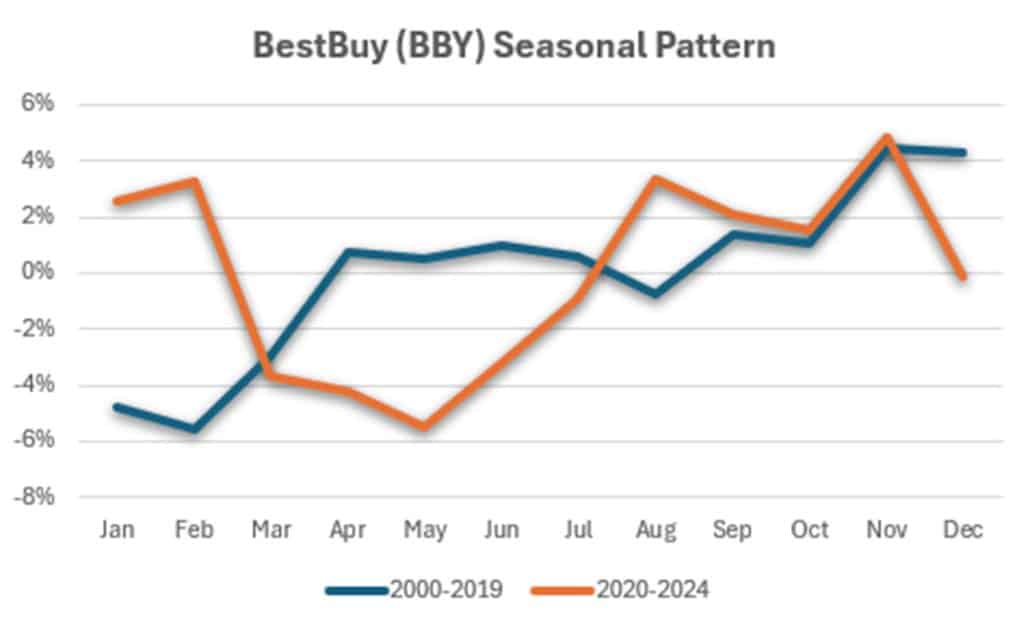
Chart 5. BestBuy (BBY) may be promoting November sales rather than December. This is not the most reliable stock to trade over the holidays.
Resorts and Vacations
Disney may be diversified, but their parks are a leading income provider. It’s not clear if they sell tickets in advance and post as profits or if it’s “unearned income,” but typically November, December, and January are good months for them (see Chart 6). Even during the past five years, the end-of-year pattern seems to hold.

Chart 6. Disney (DIS) may be back to it’s old seasonal pattern. November through January has a good chance of rallying.
MGM is a giant in Las Vegas, along with other venues and movies. The pattern of the past 5 years is similar to its long-term pattern (Chart 7) and similar to Disney; it tends to rally from November through January. Watch out for February!

Chart 7. MGM (MGM) has a similar pattern as Disney, rallying from November to January.
Caesars is another resort without the diversification of either Disney or MGM. Perhaps that’s good. It is a focused play on resorts and seems to do well except for midwinter (February and March) as shown in Chart 8.
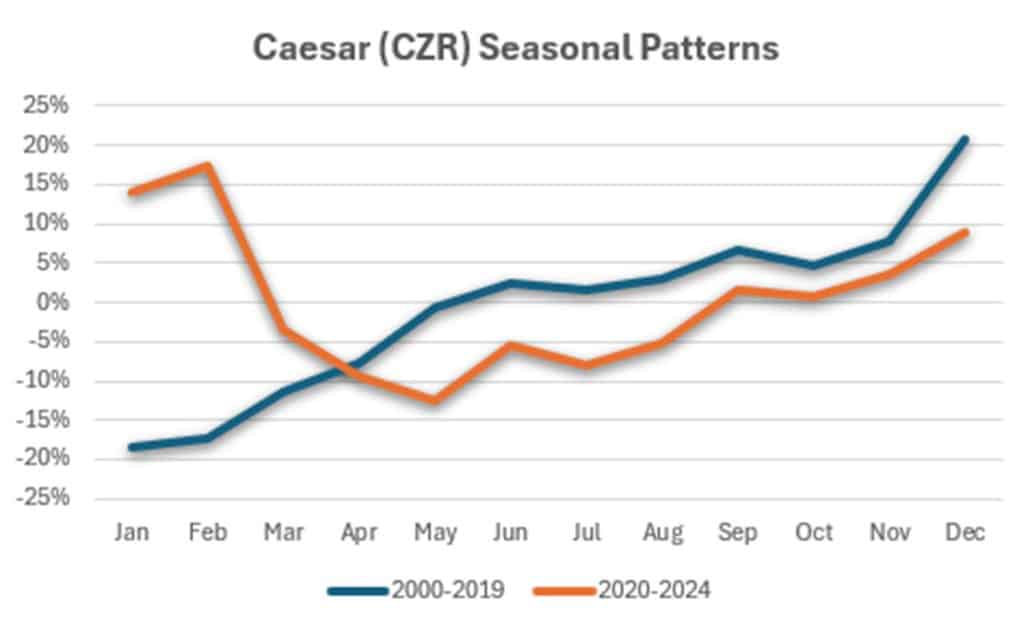
Chart 8. Caesar has a consistent pattern with only losses in February and March, typical of a seasonal lull.
And how to we get to all these resorts? Often by air. Airlines have not been the best investment, and it’s also not clear when their income occurs – when customers buy the tickets or when they use them? Chart 9 shows that the pattern has not changed much, except for losses in December. As a trader, I would stay away from airlines.

Chart 9. United Airlines (UAL) has a consistent pattern except for December in the past five years.
Hi-Tech Retailers
Saving the best for last, we look at Apple (AAPL) in Chart 10. With a few exceptions, you could buy AAPL at any time. The December rally is similar to April through August, and the only time to stay away is after the holidays, January through March.

Chart 10. Apple (AAPL) has a steady uptrend. If you are looking for a place NOT to trade, it would be January through March.
And there is always Amazon, the behemoth of retailers. Similar to Apple, it sags at the beginning of the year, but historically it can rally for the rest of the year. The past 5 years (see Chart 11) shows small declines in the second half of the year. This is a case where you need to decide what to do. I’ve looked at the yearly results, and most of the losses were in 2021 and 2022. If you’re looking for a justification to buy, that could do it.

Chart 11. Amazon (AMZN) has had a great run and shows some fading during the past few years, mostly due to 2021 and 2022.
What to Do?
The holidays are times when retailers turn a profit. To do that, they advertise and reduce prices (sort of). We expect good sales from the major retailers. With only a few exceptions, November, December, and January are typically good for retail stocks. After that, you need to be careful.
In other articles that I have written, the end of the holiday season is about 2 days after Christmas Day, the 25th. Buying does not continue to the end of the year. As always, it’s a stock-pickers market.
A Standing Note on Short Sales
Note that the “All Signals” reports show short sales in stocks and ETFs, even though short positions are not executed in the equity portfolios. Our work over the years shows that downturns in the stock market are most often short-lived and it is difficult to capture with a longer-term trend. The upwards bias also works against shorter-term systems unless using futures, which allows leverage. Our decision has been to take only long positions in equities and control the risk by exiting many of the portfolios when there is extreme volatility and/or an indication of a severe downturn.
PORTFOLIO METHODOLOGY IN BRIEF
Both equity and futures programs use the same basic portfolio technology. They all exploit the persistence of performance, that is, they seek those markets with good long-term and short-term returns on the specific system, rank them, then choose the best, subject to liquidity, an existing current signal, with limitations on how many can be chosen from each sector. If there are not enough stocks or futures markets that satisfy all the conditions, then the portfolio holds fewer assets. In general, these portfolios are high beta, showing higher returns and higher risk, but have had a history of consistently outperforming the broad market index in all traditional measures.
PERFORMANCE BY GROUP
NOTE that the charts show below represent performance “tracking,” that is, the oldest results since are simulated but the returns from 2013 are the systematic daily performance added day by day. Any changes to the strategies do not affect the past performance, unless noted. The system assumes 100% investment and stocks are executed on the open, futures on the close of the trading day following the signals. From time to time we make logic changes to the strategies and show how the new model performs.
Groups DE1 and WE1: Daily and Weekly Trend Program for Stocks, including Income Focus, DowHedge, Sector Rotation, and the New High-Risk Portfolio
The Trend program seeks long-term directional changes in markets and the portfolios choose stocks that have realized profitable performance over many years combined with good short-term returns. It will hold fewer stocks when they do not meet our condition and exit the entire portfolio when there is extreme risk or a significant downturn.
Equity Trend
Gains of more than 7% in both daily portfolio put them ahead by 19% for the year. Not quite as good as SPY, but very respectable. Keep in mind that a strategy has risk control, which most often causes a lag in performance.
The Weekly Portfolios gained nicely but are lagging the Daily Portfolios. It’s a matter of how fast sector rotation occurs and how stable it is. We never know which will be better.

Income Focus and Sector Rotation
Gains in both Daily and Weekly Income Focus programs puts them higher by about 2% for the year. That might not sound great, but fighting a rising rate market and netting a profit is good performance. We expect these programs to do much better in 2025.

Weekly Sector Rotation
Another jump of nearly 8% puts this program ahead by 35% for 2024. It is, by far, the biggest surprise of our portfolios. It has held mostly the same positions all year, gaining when other sectors are losing. At 35% it is well above all of our other portfolios as well as the major index markets.

DowHedge Programs
Higher by 10% in the Daily Program and 9% in the Weekly, this program is second only to our Sector Rotation Portfolio. Gains of 22% and 19% for the year, which reasonable drawdowns, makes this a good alternative to trading the ETF index, DIA.

High-Risk Portfolios
Traders have been on-again, off-again with tech stocks. This month had gains but overall the past few months are sideways. Is it likely that AI is no longer of interest, or if biotech is not going to do something interesting? Seems unlikely. This portfolio could offer high returns; unfortunately, we don’t know when!

Group DE2: Divergence Program for Stocks
The Divergence program looks for patterns where price and momentum diverge, then takes a position in anticipation of the pattern resolving itself in a predictable direction, often the way prices had moved before the period of uncertainty.
Another surprise for our portfolios is the Divergence program. It looks for pauses in a trend before taking the trend position. It gained 9% to 11% in November, now higher by 29% and 23% for the year. It did suffer a setback in the past year or so while the market was undecided, but now seems to be moving forward.

Group DE3: Timing Program for Stocks
The Timing program is a relative-value arbitrage, taking advantage of undervalued stocks relative to its index. It first finds the index that correlates best with a stock, then waits for an oversold indicator within an upwards trend. It exits when the stock price normalizes relative to the index, or the trend turns down. These portfolios are long-only because the upwards bias in stocks and that they are most often used in retirement accounts.
After waiting all year, the Timing program gained more than 13% and 10% in November, giving the chart below a major boost. Is it possible this is the beginning of a run?
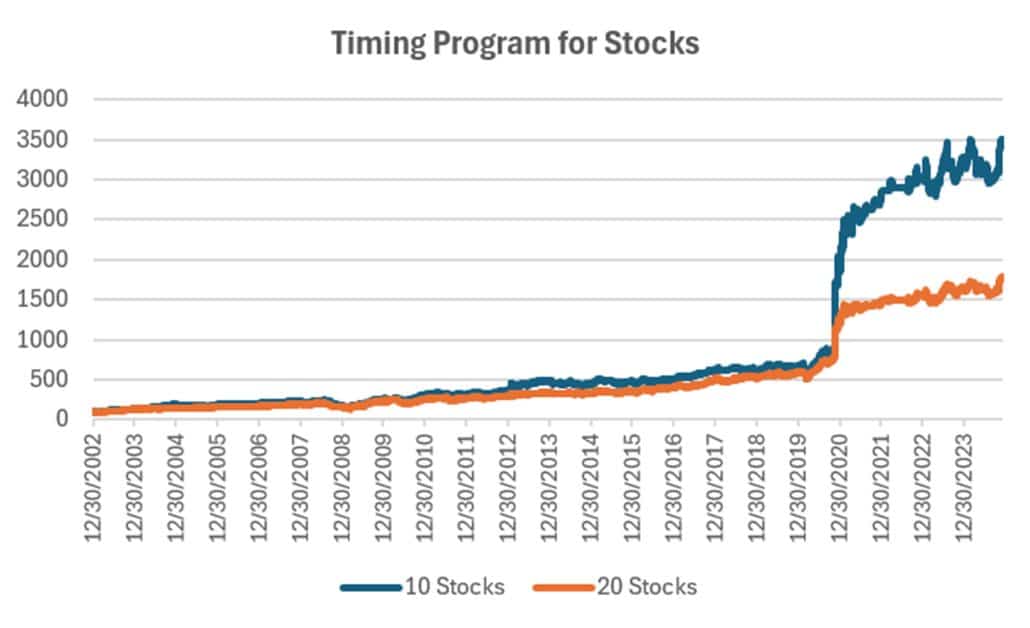
Futures Programs
Groups DF1: Daily Trend Programs for Futures
Futures allow both high leverage and true diversification. The larger portfolios, such as $1million, are diversified into both commodities and world index and interest rate markets, in addition to foreign exchange. Its performance is not expected to track the U.S. stock market and is a hedge in every sense because it is uncorrelated. As the portfolio becomes more diversified its returns are more stable.
The leverage available in futures markets allows us to manage the risk in the portfolio, something not possible to the same degree with stocks. This portfolio targets 14% volatility. Investors interested in lower leverage can simply scale down all positions equally in proportion to their volatility preference. Note that these portfolios do not trade Asian futures, which we believe are more difficult for U.S. investors to execute. The “US 250K” portfolio trades only U.S. futures.
Small gains in November keeps the pattern sideways with most portfolios showing a small loss. This program needs a trend to perform, and that’s not happening. Our expectation of a bond rally has faded given that tariffs may reverse the decline in inflation. However, the point of trading is that we never know.

Group DF2: Divergence Portfolio for Futures
Another small gain in November brings the smallest $250K portfolio higher by 11% while the larger portfolios are modestly down for the year. This has clearly not been the right market for this program.

Blogs and Recent Publications
Perry’s books are all available on Amazon or through our website, www.kaufmansignals.com.
November 2024
“Overlooked Strategy Rules” appeared in the December issue of Technical Analysis of Stocks & Commodities. We tend to overlook certain rules that can make a big difference to results. This article looks at scaling in and scaling out of a position, delayed entries, correlations, and other simple but important rules.
October 2024
“Trading a Breakout System” was published in Technical Analysis of Stocks & Commodities. It looks at whether it’s better to enter on the bullish breakout, wait for confirmation, or buy ahead of the breakout. It’s a practical look at improving breakout results.
September 2024
Two articles posted by Perry, “The N-Day or the Swing Breakout,” (Technical Analysis of Stocks & Commodities) looking to see which is better. You would be surprised.
A look at deleveraging Artificial Intelligence stocks, a shorter version of the article posted in our “Close-Up” section. It appeared in Seeking Alpha earlier in September.
August 2024
“Theory Versus Reality” was published in the August issue of Technical Analysis of Stocks & Commodities. It discusses price shocks, diversification, predicting performance, and more.
July 2024
Perry posted a new article on Seeking Alpha, “Capturing Fund Flows.” It a good strategy for someone that wants to add some diversification. It only trades 3 days each month!
June 2024
Perry was interviewed on June 27th by Simon Mansell and Richard Brennan at QuantiveAlpha (Queensland, Australia), a website heavy into technical trading. It should be posted in a week or so.
“Trading Extreme Gaps and Extreme Closes” looks at daily patterns in stocks, published in the June edition of Technical Analysis.
May 2024
In the April edition of Technical Analysis, Perry again deals with risk in “How Professional Assign Risk.” It is another chapter in how to protect yourself.
April 2024
Another article in the April edition of Technical Analysis, “Determining Risk Before It Happens.” Perry thinks this is an article everyone should read.
March 2024
In the 2024 Bonus Issue of Technical Analysis, Perry has an article, “Pros and Cons of Daily Versus Weekly Trend Following.” There is also a quote by him in the “Retrospective: Interviews” going back to April 1988.
Perry also posted an article on Seeking Alpha, “How To Exit a Trade.” A good reminder of the choices.
February 2024
Perry published an article on using the backwardation and contango in crude oil in “The Delta-Delta Strategy.” If not crude, the you might think of this for any commodity, including interest rates, that have a consistent term structure.
January 2024
A new article in February edition of Technical Analysis of Stocks & Commodities, “Crossover Trading: Arbitrating the Physical with the Stock.” A chance at diversification!
Perry posted 3 new articles on Seeking Alpha in December, “Where Do You Take Profits?”, “Is There a Better Day to Enter the Market,” and “Watching January Returns.”
Another article in Technical Analysis of Stocks & Commodities, “Gap Momentum,” another interesting way to identify the trend.
December 2023
Perry posted 3 new articles on Seeking Alpha, “Where Do You Take Profits?”, “Is There a Better Day to Enter the Market,” and “Watching January Returns.”
This month Technical Analysis of Stocks & Commodities published “A Strategy For Trading Seasonal and Non-Seasonal Market.” Turns out that most markets are non-seasonal!
Older Items of Interest
On April 18th, 2023, Perry gave a webinar to the Society of Technical Analysts (London) on how to develop and test a successful trading system. Check their website for more details, https://www.technicalanalysts.com..
Perry’s webinar on risk, given to the U.K. Society of Technical Analysts, can be seen using the following link: https://vimeo.com/708691362/04c8fb70ea
For older articles please scan the websites for Technical Analysis of Stocks & Commodities, Modern Trader, Seeking Alpha, ProActive Advisor Magazine, and Forbes. You will also find recorded presentations given by Mr. Kaufman at BetterSystemTrader.com, TalkingTrading.com, FXCM.com, systemtrade.pl, the website for Alex Gerchik, Michael Covel’s website, TrendFollowing.com, and Talking Trading.com.
You will also find up to six months of back copies of our “Close-Up” reports on our website, www.kaufmansignals.com. You can address any questions to perry@kaufmansignalsdaily.com.
© November 2024, Etna Publishing, LLC. All Rights Reserved.
